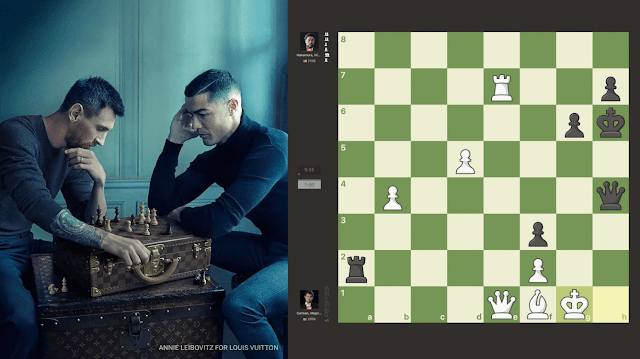This round 3 game features a Slow Slav, which as the name implies normally does not have a lot of fireworks. However, close study reveals a game more like a stand-up boxing match, where each side jabs repeatedly at the other and looks for small openings. At first it seems that Black wants to keep the position more imbalanced to seek winning chances, then White does the same. However, White overreaches and Black had one opportunity on move 26 to win material and significantly imbalance things. After that the game heads for a draw, although the dynamic balance and a need by both sides to watch their weak points is what causes it, rather than a stagnant position.
New ...
New Game
Edit Game
Setup Position
Open...
PGN
FEN
Share...
Share Board (.png)
Share Board (configure)
Share playable board
Share game as GIF
Notation (PGN)
QR Code
Layout...
Use splitters
Swipe notation/lists
Reading mode
Flip Board
Settings
| Move | N | Result | Elo | Players |
|---|---|---|---|---|
| Replay and check the LiveBook here |
Please, wait...
1.d4 d5 2.c4 c6 3.Nf3 Nf6 4.e3 the "Slow Slav" Bf5 5.Nc3 e6 6.Nh4 Be4 the point is to provoke White's next and make the Nh4 placement more awkward. 7.f3 Bg6 8.Qb3 a common theme in the Slav, White takes advantage of the Black light-square bishop's early development by targeting b7. Qc7 this has generally replaced ...Qb6 as standard. In top level master games White was consistently able to obtain a small plus and grind it after Nxg6. For Class players, it probably doesn't matter. 9.Bd2 Be7 10.0-0-0 this is the first big decision for White in the line, determining the middlegame's characteristic. Here White decides to castle long, since the kingside is not in such great shape and it makes for a more dynamic game with opposite-side castling. dxc4 releasing the central tension and the most played option here for Black. 10...a6?! 11.c5± and now the queenside is locked up with White's king safer. 10...0-0 looks like a normal move but is rarely played. It makes it relatively easy for White to play against in the middlegame, using kingside pawn thrusts. 11.Bxc4 a6 the database and engines show equal results for Black at this point. With the d/c pawns exchanged, White lacks any near-term pawn levers and Black has a solid and harmonious position. 12.Nxg6 clearly a better trade for White, given the knight has so few squares. hxg6 however Black remains very solid and still has not committed to castling, so the h-file is covered by the rook. 13.Ne4 b5 13...Nxe4 is probably a quicker way toward a draw. 14.Be2 Nbd7 again Black avoids simplification with an exchange on e4. White's knight is relatively better there, so perhaps Black was still looking to eventually play for a win rather than head for a draw. 15.Kb1 this is almost always a useful move with a queenside-castled king, covering a2 - although here the Qb3 does that as well - and clearing c1 for a rook in the future. Rc8 lining up behind Black's c-pawn lever. 16.Be1 apparently an original idea, as there are no games in my database. The repositioning of the bishop to g3 is logical, but does not cause Black any problems, and here she just proceeds with her c-pawn lever plan. 16.Nxf6+ Nxf6 17.g3= 16...c5 17.Bg3 Qc6 it is difficult to know exactly where to put the queen in these kinds of positions. 17...Qb6!? would keep the queen off the c-file and potentially pressure e3. 18.Nxc5 Nxc5 19.dxc5 Bxc5 20.Be5 20.Rc1 seems more to the point, although Black can simply castle and then play ...Qb7 to break the pin. 20...0-0 Black would welcome an exchange on f6, giving Black control over e5, space for the king on g7, and elminating White's better bishop. 21.h4 sometimes White can take advantage of this type of pawn structure by using the doubled g-pawn as a target. However, this is not one of those times. Rfd8 now Black is apparently happy with getting material off the board. 22.Rxd8+ Rxd8 23.Rc1 23.Qc2!? 23...Rd5 Black's rook is now quite effective on the d-file, provoking the piece exchange. 24.Bxf6 gxf6 Black now has a small space advantage and White has no real prospects for making progress. 25.Qc3 Qd7 26.h5?! White now evidently wants to avoid heading for a draw, but creating this imbalance in the position would allow Black to do something similar on the queenside and with better effect. However, Lee continues with solid play, protecting the f6 pawn instead of counterattacking. 26.e4 Rd2 27.Qxc5 Rxe2 28.Qc8+ Qxc8 29.Rxc8+ Kg7 30.Rc2= 26...Be7 26...b4 the engine spots this opportunity. 27.Qxf6? Bxe3 28.hxg6 this is not as scary as it looks and Black can win material. Bxc1 and now White has nothing better than 29.Kxc1 Rc5+ 30.Kb1 a5 consolidating the queenside. Now Black's king could be subjected to a number of checks, but no real attack after 31.g4 fxg6 32.Qxg6+ Kf8-+ 27.hxg6 the moment of imbalance passes. fxg6 28.f4 Rc5 29.Qb3 Rxc1+ 30.Kxc1 Qc6+ with more material off the board and no breakthroughs possible without a blunder, the game now heads for a draw. Black will try to target the b- and e- pawns on dark squares, but White finds a dynamic counter. 31.Kd1 Qe4 32.Bf3 Qb1+ 33.Ke2 Kf7 34.a3 f5 fixing the White e-pawn. 35.g4 Bf6 targeting b2, but White can counter with 36.gxf5 gxf5 37.Bh5+ and Black's king position is too exposed to get away from the checks, since the e6 pawn has to be protected. Ke7 38.Qb4+ Kd7 39.Qd2+ Ke7 40.Qb4+ Kd7 41.Qd2+ Ke7 42.Qb4+ ½–½
- Start an analysis engine:
- Try maximizing the board:
- Use the four cursor keys to replay the game. Make moves to analyse yourself.
- Press Ctrl-B to rotate the board.
- Drag the split bars between window panes.
- Download&Clip PGN/GIF/FEN/QR Codes. Share the game.
- Games viewed here will automatically be stored in your cloud clipboard (if you are logged in). Use the cloud clipboard also in ChessBase.
- Create an account to access the games cloud.
| White | EloW | Black | EloB | Res | ECO | Rnd |
|---|---|---|---|---|---|---|
| Cervantes Landeiro,T | 2272 | Lee,A | 2263 | ½–½ | D12 | 3 |
Please, wait...










.jpg)










